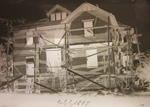Photographic Processes: 1839 – 1889
DRY PLATE NEGATIVE (gelatin dry plate), 1880-1920
Silver-based negative on glass with gelatin as a binder to contain light sensitive materials
Gelatin is mixed with light sensitive materials, forming an emulsion that is machine-coated in one step onto large sheets of glass. The glass sheets are then cut down to the desired sizes. Because the negatives are exposed dry, the process is called dry plate negative. Machine manufacturing results in negatives with clean edges and no hand-pouring patterns.
 |
Liberty Hyde Bailey. Dry Plate Negative. Liberty Hyde Bailey Residence, July 6, 1889. [zoom] 8 ½ x 6 ½ in. |